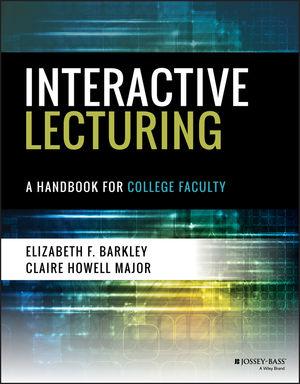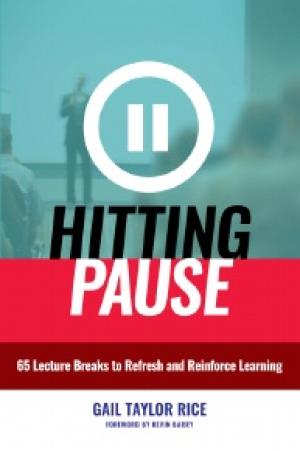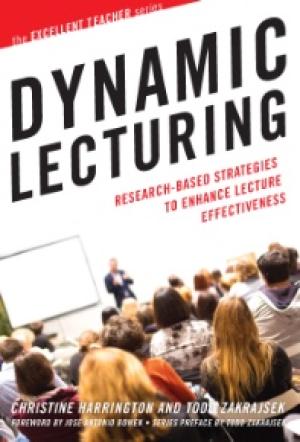Resources

Click Here for Book Review Have you ever looked out across your students only to find them staring at their computers or smartphones rather than listening attentively to you? Have you ever wondered what you could do to encourage students to resist distractions and focus on the information you are presenting? Have you ever wished you could help students become active learners as they listen to you lecture? Interactive Lecturing is designed to help faculty members more effectively lecture. This practical resource addresses such pertinent questions as, “How can lecture presentations be more engaging?” “How can we help students learn actively during lecture instead of just sitting and passively listening the entire time?” Renowned authors Elizabeth F. Barkley and Claire H. Major provide practical tips on creating and delivering engaging lectures as well as concrete techniques to help teachers ensure students are active and fully engaged participants in the learning process before, during, and after lecture presentations. Research shows that most college faculty still rely predominantly on traditional lectures as their preferred teaching technique. However, research also underscores the fact that more students fail lecture-based courses than classes with active learning components. Interactive Lecturing combines engaging presentation tips with active learning techniques specifically chosen to help students learn as they listen to a lecture. It is a proven teaching and learning strategy that can be readily incorporated into every teacher’s methods. In addition to providing a synthesis of relevant, contemporary research and theory on lecturing as it relates to teaching and learning, this book features 53 tips on how to deliver engaging presentations and 32 techniques you can assign students to do to support their learning during your lecture. The tips and techniques can be used across instructional methods and academic disciplines both onsite (including small lectures and large lecture halls) as well as in online courses. This book is a focused, up-to-date resource that draws on collective wisdom from scholarship and practice. It will become a well-used and welcome addition for everyone dedicated to effective teaching in higher education. (From the Publisher)

Click Here for Book Review Pauses constitute a simple technique for enlivening and enhancing the effectiveness of lectures, or indeed of any form of instruction, whether a presentation or in an experiential setting. This book presents the evidence and rationale for breaking up lectures into shorter segments by using pauses to focus attention, reinforce key points, and review learning. It also provides 65 adaptable pause ideas to use at the opening of class, mid-way through, or as closers. Starting with brain science research on attention span and cognitive load, Rice bases her book on two fundamental principles: shorter segments of instruction are better than longer ones, and learners who actively participate in instruction learn better than those who don’t. Pausing helps teachers apply these principles and create student engagement without requiring major changes in their lesson plans. With careful planning, they can integrate pauses into learning sessions with ease and significantly reinforce student learning. They will also gain feedback on students’ comprehension. Rice sets out the characteristics of good pauses, gives advice on how to plan them and how to introduce them to maximum effect. She provides compelling examples and concludes with a repertory of pauses readers can easily modify and apply to any discipline. This book contains a compendium of strategies that any teacher can fruitfully use to reinforce learning, as well as a stepping stone to those seeking to transition to more active learning methods. It: • Makes the case for using pauses • Identifies the primary functions of pauses: focusing, refocusing, enhancing retention, or closing off the learning experience • Provides research evidence from cognitive science and educational psychology • Provides practical guidance for creating quick active learning breaks • Distinguishes between starting, middle, and closing pauses • Includes descriptions, with suggested applications, of 65 pauses (From the Publisher)

Click Here for Book Review Is the lecture an outmoded teaching method that inhibits active learning or is it a potentially powerful tool that is an essential part of every teacher’s repertoire? This book presents up-to-date research on the different types of lecture, on what constitutes effective lecturing, and on the impact of lecturing when done appropriately and well. It fills the void in professional development resources on how to lecture, validating the practice when it’s aligned with the educational mission of creating engaged learning environments. Christine Harrington and Todd Zakrajsek demonstrate that, rather than lecture and active learning being mutually exclusive or either-or propositions, the effectiveness of the former can be greatly enhanced when combined with active learning techniques through what they define as dynamic lecturing; and provide context about the need to balance these approaches to meet the needs of students as they progress from novice to advanced learners. They present a range of strategies that enhance student learning during lectures. They open each chapter with the evidence behind each lecturing strategy they describe, and conclude with practical suggestions for quick application in the classroom. They offer readers the lecture planning and evaluation tools for reworking their lectures in ways that provide high-level engagement and achievement for their students. The opening section of the book explores the benefits of lecturing and describes the different modalities of lecture, with an assessment of the advantages and disadvantages of each. The second section focuses on educational strategies to enhance the lecture, including, among others, activating prior knowledge, emphasizing important points, effectively using multi-media, making concepts meaningful via examples, and the importance of retrieval practice. Each covers the underlying theory and research, and advice on how to align the engagement techniques with instructional goals. The book concludes with guidance on effective planning for lecturing and helping chairs, administrators, or peers engage in effective evaluation of the lecture. This is a dynamic resource for all faculty interested in revitalizing their teaching. The strategies are succinct, easy to incorporate into lectures and, done well, will have immediate impact and increase student mastery of course content. (From the Publisher)
A simple and short chart that provides  a few simple strategies for making lectures more interactive. 
An overview of research in cognitive psychology, linguistics, and teaching science. 1) note taking strategies used by students; 2) the different factors involved in comprehension through note taking; 3) “writing to learn”; 4) the learning contexts that allow effective note taking.
Reviews research on the impact of notetaking and how the review of notes affects student learning. The paper also explores the role that instructors can play, suggesting several specific strategies to support students. 
Based on archival research, this article analyses the pedagogical gestures in Derrida’s (largely unpublished) lectures on hospitality (1995/96), with particular attention to the enactment of hospitality in these gestures. The motivation for this analysis is twofold. First, since the large-group university lecture has been widely critiqued as a pedagogical model, the article seeks to retrieve what may be of worth in the form of the lecture. Second, it is relevant to analyze the pedagogy of lectures that address the topic of hospitality, as there would be a performative contradiction in teaching inhospitably about hospitality.
Video. A video from The Harvard Graduate School of Education "Master Class" series. Eric Mazur (physics instructor) demonstrates how to conduct in-class activities without TAs.